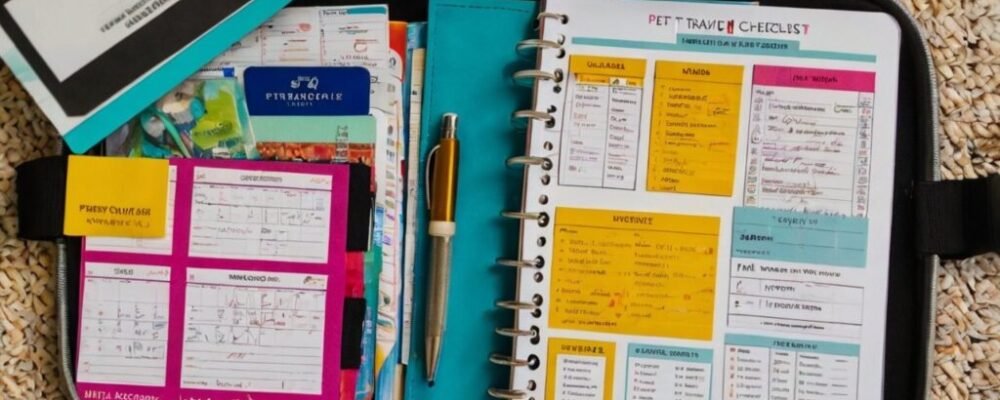USDA Pet Travel Guide: Avoid Delays with Pro Tips & Checklist
Planning to take your furry companion on an international adventure? Then you’ve likely heard about the USDA pet travel process—a critical requirement for ensuring your pet meets foreign entry regulations. However, recent traveler reports reveal growing frustration over delays in receiving USDA-endorsed health certificates, leaving many pet owners scrambling just days before departure. In this guide, we’ll break down the current USDA pet travel requirements, explore the causes of recent processing slowdowns, and provide expert tips to help you navigate the process smoothly and avoid costly disruptions.

🐾 Chapter 1: Understanding the USDA Pet Travel Process
🧾 What is the USDA Pet Travel Certificate and Why Is It Important?
When it comes to international adventures with your furry friend, USDA Pet Travel requirements are the key to a smooth takeoff. Whether you’re jetting off to Europe, Asia, or a tropical island escape, many countries require a USDA-endorsed health certificate to allow pets entry without quarantine or fines.
This document, officially called the APHIS 7001 form or export health certificate, is issued by a USDA-accredited veterinarian and endorsed by a USDA office. It confirms your pet is healthy, vaccinated, and fit to travel.
Depending on your destination, this certificate must meet specific country requirements—some even require rabies titer tests, microchipping, or parasite treatment records.
🔗 For more global travel inspiration, check out our guide to 2025 travel trends and top destinations.
📌 Key Elements of the USDA Pet Travel Certificate
-
🩺 Health Check-Up: Your pet must be examined by a USDA-accredited vet within the timeline specified by your destination country (often 10 days or fewer before travel).
-
💉 Vaccination Records: Rabies, distemper, and other vaccinations must be current.
-
📄 Paperwork Review: All forms must be accurate and complete—any errors can lead to rejection or costly delays.
-
✉️ USDA Endorsement: The final certificate is submitted to a USDA office (often via the VEHCS online system) for stamping and approval.
Need help booking airport transport for you and your pet? Use this door-to-door airport transfer service to make your travel day smoother.
🐶 USDA Pet Travel Is Not Just for Dogs and Cats
While dogs and cats are the most common travel companions, USDA pet travel rules also apply to birds, rabbits, and even reptiles in some cases. The complexity increases with exotic pets, and not all countries permit them.
Explore hidden paradises you and your pet might enjoy together in Southeast Asia’s best-kept travel secrets.
📅 When Should You Start the USDA Pet Travel Process?
Timing is everything. Ideally, you should start your USDA pet travel preparations 30–60 days in advance of your departure, especially if:
-
You’re traveling during peak seasons (like holidays or summer).
-
Your pet requires additional tests like blood titers or special vaccines.
-
You live in a state with limited access to local USDA offices.
Check with your vet about using VEHCS (Veterinary Export Health Certification System) to streamline your application digitally.
💼 Bonus Tip: Combine Pet Travel Prep With Other Travel Must-Haves
Before you pack your bags and your pup’s treats, don’t forget:
-
Secure a travel insurance plan that covers pets.
-
Book your hotels and flights early to ensure they’re pet-friendly.
-
Get a universal eSIM so you can stay connected to your vet or USDA updates abroad.
Need to compare flights quickly? Use this flight deal aggregator to find the best pet-friendly routes.

🚨 Chapter 2: What’s Going On with USDA Pet Travel Delays?
😟 USDA Pet Travel Certificate Delays Are Causing Last-Minute Panic
If you’ve been scrolling Reddit or international travel forums lately, you’ve likely seen the rising number of posts from frantic travelers sharing their horror stories about USDA Pet Travel delays. From cross-country moves to dream vacations, pet owners are finding themselves in bureaucratic limbo just days before takeoff—unable to get their export health certificates on time.
One Reddit user recently shared:
“My vet submitted everything through VEHCS five days before travel… still no response. I’ve called every day and it’s just stuck in ‘pending review.’ This is our only flight window to Korea!”
These aren’t isolated incidents. Reports of processing delays at USDA offices—especially during peak travel months—have become so frequent that some travelers are rebooking flights or leaving their pets behind.
🧠 Why Are There Delays in the USDA Pet Travel Process?
There are several key reasons for the recent slowdowns:
-
Increased travel post-pandemic: More travelers are moving or vacationing abroad with pets in tow.
-
Staff shortages at USDA offices: Many local centers are overwhelmed, especially in large states like California, Florida, and New York.
-
Incomplete paperwork from veterinarians: If your USDA-accredited vet makes even a small mistake, your submission could be delayed or rejected.
-
Reliance on VEHCS: While the VEHCS system is meant to speed things up, travelers report technical hiccups and long response times.
If you’re planning to travel during holiday seasons or to popular 2025 destinations like Norway’s fjords or Singapore (see guide), it’s wise to start your pet travel process 6–8 weeks ahead.
📞 Real Tips from Travelers Stuck in the System
-
Call your USDA office directly (politely, and early in the morning).
-
Double-check all documents for errors before your vet submits them.
-
Use VEHCS where possible, but have a backup printed copy ready.
-
If you’re near a USDA office, consider making an in-person appointment.
-
Build in buffer time before your departure.
🚘 Need to reach your USDA appointment from a rural area? Try this airport transfer platform that includes pet-friendly ride options.
🧳 If You’re Traveling Soon: Your Backup Checklist
If your certificate is delayed, here are a few ways to reduce stress:
-
Rebook flights with flexible cancellation using platforms like Aviasales
-
Have your pet boarded locally while you finalize paperwork
-
Talk to your airline about rebooking fees or pet travel rules
-
Browse short-notice travel getaways you could enjoy while waiting
🌐 Don’t Let USDA Delays Stop Your Travel Dreams
While USDA Pet Travel delays can be frustrating, they’re not impossible to navigate. With early preparation, reliable vet support, and a bit of patience, your journey can still be a smooth one—for both you and your pet.
Want to learn about destinations that are perfect for pet travelers? Explore these coolcation getaways to escape the heat—pet optional, stress not.

⚠️ Chapter 3: Common Causes of USDA Pet Travel Delays
🕵️♀️ What’s Holding Up Your Pet’s USDA Travel Certificate?
You’ve done the responsible thing—scheduled your vet visit, filled out your forms, and submitted everything to the USDA. So why is your USDA pet travel certificate still stuck in “pending”? 😖 The answer lies in a few surprisingly common mistakes and system bottlenecks that can derail even the most organized pet parent’s plan.
Let’s break down the typical culprits behind these frustrating hold-ups and show you how to dodge them.
📋 1. Incomplete or Incorrect Documentation
Even a minor typo—a mismatched microchip number, expired rabies certificate, or missing signature—can send your file straight to the bottom of the stack. USDA officials are required to reject incomplete submissions, no matter how small the error.
✅ Pro Tip: Double-check everything, especially:
-
Pet’s name and breed
-
Microchip number (must be ISO 11784/11785-compliant)
-
Rabies vaccine details (validity, manufacturer, lot number)
-
Vet’s signature and USDA accreditation number
📎 If you need a full checklist, pair this guide with our long flight survival tips—you’ll thank yourself later.
🧑⚕️ 2. Your Veterinarian Is Not USDA-Accredited
Only USDA-accredited veterinarians can issue valid export health certificates. Surprisingly, not all general vets are accredited—especially those in small clinics or rural towns.
➡️ Use the USDA’s search tool or ask directly before booking your appointment.
🩺 Consider pairing this with travel medical insurance that covers veterinary consultations abroad, especially for longer international stays.
🧨 3. Rushed Timelines and Tight Travel Windows
Many pet owners wait until the last minute, unaware that the USDA may need 3–5 business days (or more) to process documents—longer during holidays or peak travel periods.
🗓️ Start your USDA Pet Travel prep at least 30 days ahead, and don’t schedule your vet visit too close to your departure. You need buffer time for corrections, endorsements, and shipping.
🌍 Traveling somewhere remote or spontaneous? Our last-minute travel guide can help you plan better next time—without the paperwork panic.
🖥️ 4. VEHCS System Glitches or Backlog
The Veterinary Export Health Certification System (VEHCS) is designed to streamline USDA approvals. But when thousands of pet owners submit forms all at once, the system gets overwhelmed—and delays follow.
If you’re submitting digitally, be sure to:
-
Use compatible browsers (Chrome or Edge recommended)
-
Upload high-quality scans of documents
-
Confirm submission with your vet and track response status daily
💻 Some travelers still prefer submitting by mail or in-person—if you’re nearby a USDA center, this may be faster.
Need a pet-safe ride to your USDA appointment? Use KiwiTaxi for door-to-door comfort.
🛂 5. Country-Specific Entry Rules You Didn’t Know About
Each country has different pet entry requirements. A certificate valid for Canada might be invalid for Japan, or require quarantine in Australia. If you don’t follow the right timeline or vaccine protocol, USDA will not endorse your form.
🌏 Our smart travel tech guide has great tools to help you stay updated on country-specific rules in real time.
🔁 Summary: How to Avoid These USDA Pet Travel Pitfalls
| Mistake | Impact | How to Avoid |
|---|---|---|
| Incomplete paperwork | Rejection/delay | Use a pre-check checklist |
| Non-accredited vet | Invalid certificate | Confirm vet status early |
| Short timeline | Certificate arrives late | Start process 30+ days ahead |
| VEHCS issues | Application gets stuck | Submit early, track status |
| Wrong country rules | Entry denied | Research entry requirements |
🧭 Want a Stress-Free Travel Plan?
From pet docs to flights and SIM cards, start planning with these essentials:
-
Hidden gems in Europe—perfect for you and your travel buddy 🐕🧳

⏳ Chapter 4: USDA Pet Travel Timeline & Ultimate Checklist
📅 How Early Should You Start the USDA Pet Travel Process?
When it comes to USDA Pet Travel, timing isn’t just important—it’s everything. Start too late, and you risk last-minute panic, rejected paperwork, or worse, leaving your beloved pet behind.
The ideal timeline depends on your destination country, but for most travelers, the safe zone is to begin at least 30–60 days before departure. Some countries require additional tests—like rabies titers—that take weeks to process.
Planning ahead also gives you time to:
-
Fix document errors
-
Wait out USDA backlogs
-
Rebook if needed without high costs
📍Tip: Traveling in peak seasons or to strict-entry countries (like Australia, Japan, or the UK)? Start planning 90+ days ahead.
Looking for more smart destination picks for 2025? Choose wisely based on your pet’s eligibility.
✅ The Ultimate USDA Pet Travel Checklist (Step by Step)
Here’s your no-fail, time-sensitive checklist to ensure a smooth journey:
🔹 60–90 Days Before Travel
-
Research pet import rules of your destination (official gov websites or APHIS Pet Travel portal)
-
Confirm your veterinarian is USDA-accredited
-
Microchip your pet if required
-
Begin rabies titers or booster if needed
🔹 30–45 Days Before Travel
-
Schedule your pet’s health exam
-
Gather vaccine records, microchip proof, parasite treatments
-
Get any required lab testing (tick/flea treatment, deworming)
-
Prepare your pet’s crate for IATA compliance
✈️ Need a flight that accommodates pets in-cabin? Use this flight search tool to find pet-friendly options.
🔹 14–21 Days Before Travel
-
Have your vet fill out the health certificate
-
Submit the documents via VEHCS or mail to your USDA office
-
Book an in-person USDA endorsement appointment if needed
-
Schedule your USDA-approved courier or overnight delivery (if mailing)
Need a ride to your USDA office? Try this door-to-door pet taxi service.
🔹 3–7 Days Before Travel
-
Confirm certificate has been endorsed and returned
-
Review all documents for accuracy
-
Confirm airline requirements (crate size, paperwork, carrier policy)
-
Prepare travel bag: water, leash, pee pads, treats, meds, comfort toy
🧳 Download our long-haul flight hacks to keep both you and your pet comfy.
🔹 Travel Day
-
Feed your pet 4–6 hours before the flight
-
Arrive at the airport early for document review
-
Attach health cert & microchip info to the pet’s carrier
-
Stay calm—your pet picks up on your energy!
📦 Bonus: Emergency Pet Travel Pack
For peace of mind, always pack:
-
2 copies of all documents
-
Printed vet contact info
-
Digital backups in cloud/email
-
eSIM or international mobile data plan to stay connected
🌟 Tip: You can also explore pet-friendly destinations in Southeast Asia if you’re traveling on a budget.
🎯 Summary: USDA Pet Travel Timeline at a Glance
| Days Before | Task |
|---|---|
| 90 | Research entry rules, vet check |
| 60 | Begin tests, microchip, booster |
| 30 | Health exam, collect documents |
| 14 | Submit certificate to USDA |
| 7–3 | Final confirmations, review forms |
| Travel Day | Print, pack, fly, breathe |

🧳 Chapter 5: Pro Tips from Travelers Navigating USDA Pet Travel
🧠 Real Advice from Pet Parents Who’ve Been There
Anyone who’s dealt with USDA Pet Travel will tell you: it’s a rollercoaster of paperwork, planning, and persistence. While official resources provide the “what,” frequent flyers and expats provide the “how.”
We’ve gathered top advice from travelers on Reddit, Facebook groups, and forums—those who’ve braved USDA offices, missed flights, and finally landed abroad with their four-legged companions.
If you’re serious about stress-free pet travel, keep reading. These are the unfiltered, field-tested tips you’ll wish you knew sooner.
🐾 1. Schedule Extra Time — Then Add More
“USDA says 3–5 business days, but mine took 8. I was lucky my flight was delayed.”
Always add at least 7–10 days of cushion between vet visit and travel date. Certificates often get delayed due to:
-
Backlogged USDA offices
-
Weekends/holidays
-
Document errors that need resubmitting
💬 Tip: If you’re flying to high-demand spots like Singapore or Norway, plan even earlier.
📞 2. Call the USDA Office — But Be Polite, Not Pushy
“I called at 8:02 AM and actually reached a human. They were helpful—just overwhelmed.”
If your application is stuck, don’t hesitate to call your local USDA office. Most are short-staffed, so kindness goes a long way.
📍Locate your nearest USDA office via the official directory.
✍️ Some travelers even recommend following up with an email and your VEHCS submission number in the subject line for faster tracking.
📦 3. Always Use a Tracked Courier or FedEx Overnight
“USPS lost my original. I had to drive 5 hours to the USDA office to get a new cert the day before flying.”
It may seem old-fashioned, but if you’re mailing documents instead of using VEHCS, use FedEx Overnight with tracking. Include a prepaid return envelope and a printed checklist of enclosed items.
Need help getting to a vet or courier in another city? Try Intui Travel for reliable transfers with pet options.
📄 4. Print Everything — Twice
“The airport staff had no idea what the USDA certificate even was. Good thing I had copies!”
Some airline agents aren’t trained in USDA forms. Bring:
-
2 printed copies of your endorsed health certificate
-
Proof of vaccinations
-
Pet’s microchip info
-
Vet contact details
Bonus: Upload a digital backup to your cloud or email in case your luggage goes missing.
💼 5. Prepare for Customs Like a Pro
“In Tokyo, they asked for everything… twice. And in a binder.”
Have all your paperwork in order and accessible. Use a folder with labeled tabs for:
-
USDA certificate
-
Vaccination records
-
Blood test results
-
Entry forms required by your destination
🐶 Want to know where customs is easiest? Check out our top travel dupes & low-hassle countries.
🧴 6. Pack for Pet Comfort Too
“I forgot pee pads. The dog peed in the carrier mid-flight. Lesson learned.”
In your carry-on, include:
-
Collapsible bowl
-
Treats/snacks
-
Medications
-
Waste bags
-
Favorite toy
-
Pee pad or liner
Need more ideas? Here’s a long-haul travel checklist to keep your pet (and you) chill at 30,000 feet.
🧭 Final Words from the Pros
The USDA Pet Travel process can be stressful, but thousands of travelers succeed every year. The secret? Planning ahead, triple-checking documents, and treating the process like a mission—not an afterthought.
As one seasoned traveler put it:
“If you treat it like you’re smuggling a baby panda across borders, you’ll do fine.”

❓ Chapter 6: USDA Pet Travel FAQ
✈️ Do all pets need a USDA pet travel certificate?
Answer: Not all pets, but most traveling internationally do require a USDA-endorsed health certificate—especially cats and dogs. Some exceptions apply for:
-
Service animals (depending on destination)
-
Domestic travel within the U.S.
-
Certain territories and low-risk countries
🔗 Double-check country-specific rules at the APHIS Pet Travel website.
🧑⚕️ Can any vet issue a USDA pet travel certificate?
Answer: No. Only USDA-accredited veterinarians are authorized to issue export health certificates. If your regular vet isn’t accredited, they must refer you to one who is.
👉 Tip: Call ahead and confirm vet accreditation before booking your appointment. Want a full checklist? Start here: Ultimate USDA Travel Checklist →
🐶 What documents are required for USDA pet travel?
Answer:
-
Valid rabies certificate
-
Vaccination records
-
Microchip information
-
Vet-signed health certificate (specific to destination country)
-
USDA endorsement (digital via VEHCS or hard copy via mail/in-person)
📁 We recommend carrying at least two printed copies plus digital backups stored in your travel eSIM cloud.
⏳ How long does USDA endorsement take?
Answer: USDA offices generally process documents in 3–5 business days, but during peak seasons or staff shortages, it can take longer (up to 10+ days).
💬 Pro tip from travelers: Submit everything at least 2 weeks before departure and call your USDA office to confirm receipt.
🛂 What if the destination country changes rules last minute?
Answer: It happens! Countries may update entry requirements with little warning. That’s why it’s smart to:
-
Bookmark your country’s official travel page
-
Subscribe to embassy alerts
-
Have a flexible travel plan or backup pet care arrangement
For flexible last-minute ideas, browse our spontaneous travel guide.
🐾 Can I fly without a USDA certificate if I’ve traveled with my pet before?
Answer: No. Every international trip requires a new certificate, even if it’s the same pet and destination. The document must be signed and dated within a country-specific timeframe—usually 10 days before entry.
✈️ Want smoother travel next time? Explore these pet-friendly destinations with relaxed policies.
📦 What if my USDA paperwork gets delayed or lost?
Answer: Don’t panic. Here’s what you can do:
-
Call your USDA office immediately with tracking ID or VEHCS number
-
Visit in person, if possible
-
Have a flexible ticket that can be rebooked (use Aviasales to compare rebooking terms)
💼 Always pack backups: digital, printed, and even on your phone wallpaper if needed!
🧳 Bonus Question: What else should I pack for international pet travel?
Answer:
-
Health certificate + copies
-
Emergency contact info
-
Medications
-
Calming treats
-
Collapsible bowls
-
Crate liner or pee pads
-
Comfort item from home
💡 Check out our long-haul flight hacks for both human and animal comfort.
✅ Wrapping Up: You’re Ready for USDA Pet Travel
Traveling with pets is a challenge—but with preparation, it’s absolutely doable. This guide has given you:
-
A USDA travel process breakdown
-
Insider pro tips
-
A step-by-step checklist
-
Crisis prevention strategies
You’re not just a pet owner anymore—you’re a pet travel pro 🐕🧳🌍

🏁 Conclusion: Your USDA Pet Travel Journey Starts Here
Navigating the world of USDA Pet Travel may feel like decoding a secret government mission—but with the right prep, clear checklists, and a bit of patience, you and your pet can embark on unforgettable adventures across borders.
From understanding the certificate process, to avoiding delays, to hearing real advice from seasoned travelers—you now have everything you need to plan smarter and travel better.
Whether you’re off to the cool fjords of Norway, the bustling streets of Singapore, or a hidden paradise in Southeast Asia, your pet deserves a smooth, stress-free journey. 🐶✈️🐱
📣 Now It’s Your Turn — Let’s Make It Happen:
✅ Download our printable USDA Travel Checklist PDF
✅ Compare pet-friendly flights with Aviasales
✅ Stay connected abroad with a travel eSIM via Airalo
✅ Plan a relaxing, pet-friendly escape using our Top Destinations Guide
💌 Want more insider pet travel tips, deals, and destination guides?
Subscribe to our newsletter and get free resources straight to your inbox.
Traveling with pets isn’t just about logistics—it’s about love, loyalty, and sharing the journey.
Don’t let paperwork stop you. Let the world be your (pet-friendly) playground. 🧳🐾
Please log in to access your exclusive content.
Don’t have an account? Click the “Register” button below to sign up.




